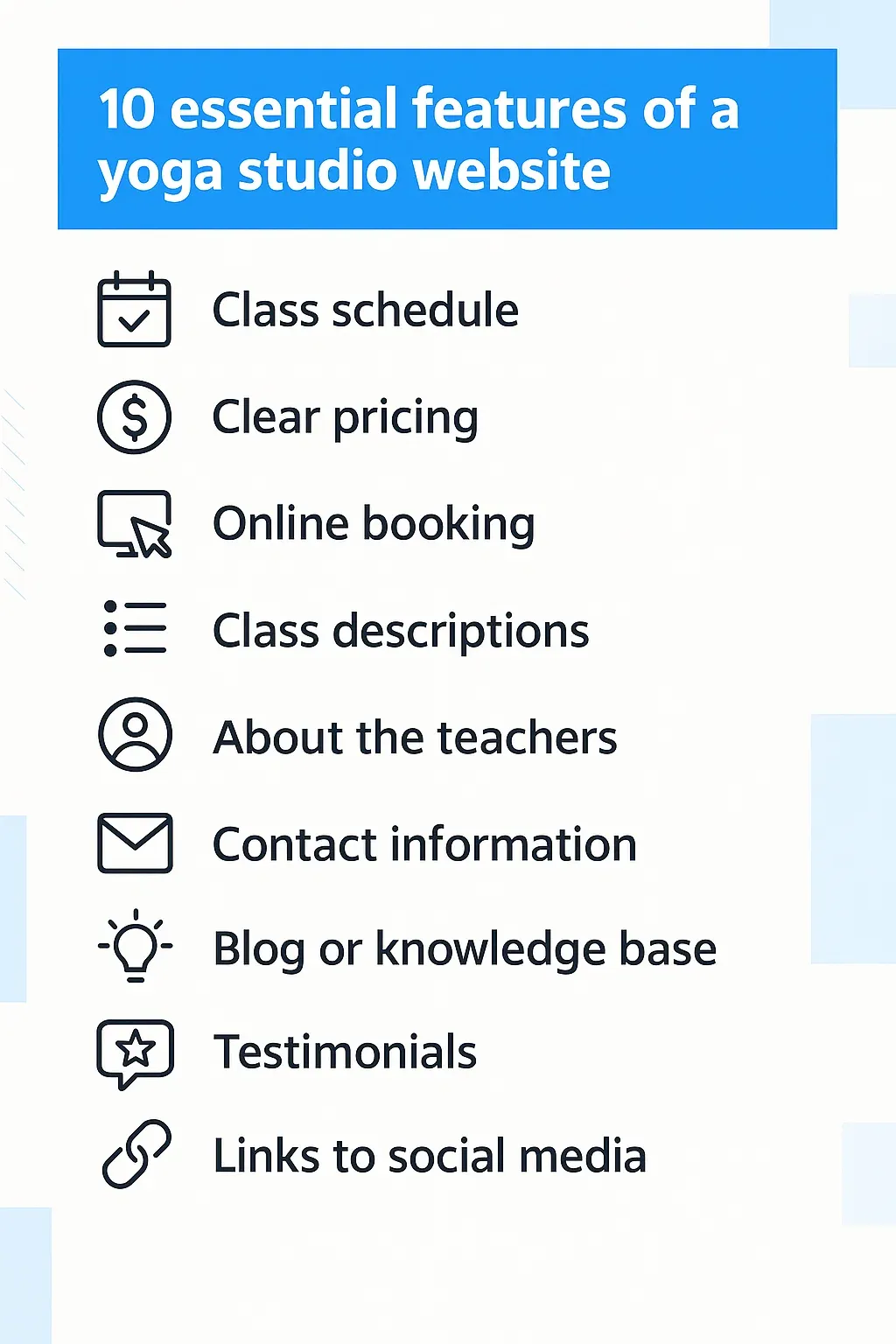How to build a yoga studio website
A great yoga studio deserves a great website — one that reflects its spirit, builds trust, and makes it easy for people to join. The good news? You don’t need to hire developers or spend thousands of dollars. With modern no-code tools like SpreadSimple, building your own professional site is simple, fast, and affordable.
Whether you're just opening your doors or upgrading an outdated site, this guide will walk you through how to create a beautiful, effective website for your yoga studio — step by step.
Step-by-step: Create your yoga studio website with SpreadSimple
You don’t need coding skills or design experience to launch a site with SpreadSimple. Just follow these simple steps to get your studio online in under an hour:
1. Sign in with your Google account. Go to SpreadSimple and sign in using your Google account. No need to create a new profile — it's quick, secure, and hassle-free.
2. Choose the Yoga Studio template. Pick the ready-made Yoga Studio template. It's built specifically for yoga businesses and comes with all the key pages you need — schedule, pricing, instructor bios, and more.

3. Add your data via Google Sheets. Once you pick a template, a connected Google Sheet will be created automatically. Use it to add your class schedules, prices, instructor info, and service descriptions. Updating the site later is as simple as editing the sheet.
4. Customize the website’s design. Head to the editor to adjust your site’s layout, colors, fonts, and images. Upload real photos of your space and team — authenticity matters. You can personalize everything without touching code.
5. Connect a custom domain. For a professional first impression, get a custom domain like yourstudio.com. A custom domain helps clients find and trust your studio online. It’s easy to set up in SpreadSimple — just follow our guide on how to choose a perfect domain name for your site and watch this video to learn how to purchase and set up a custom domain:
6. Add content pages: instructor bios & class info. Create dedicated pages for each instructor with their background, yoga style, and approach. Add clear class descriptions — including difficulty level, duration, and benefits — to help users make informed choices.
7. Set up a payment system. SpreadSimple supports integration with payment tools, so clients can book and pay for classes directly on your site. This makes scheduling frictionless and saves admin time.
8. Hit publish. Once everything looks good, hit “Publish” — and your site is live. You now have a fast, functional website that’s easy to manage and built to convert visitors into students.
10 essential features your yoga studio website needs

Your website should reflect your studio’s personality — but it also needs to make things easy for visitors. Here’s what every great yoga website should include:
1. Class schedule. Your visitors need to know when and where your classes happen. Make your schedule visible on the homepage or a dedicated “Classes” page. You can list weekly classes or embed a dynamic calendar from Google Calendar or Calendly.
2. Clear pricing. Be upfront about pricing. Add a simple chart or list that shows class passes, drop-in rates, memberships, and any intro offers. Avoid PDFs — make sure prices are easy to read on mobile.
3. Online booking. Make it easy for people to sign up. Use tools like Calendly, TidyCal, or embedded Google Forms to let users book classes, consultations, or special events directly from your site.
4. Class descriptions. Help visitors understand what each class offers. Write short, friendly descriptions for each class type (e.g., Vinyasa, Hatha, Yin), including the level (beginner, intermediate) and the focus.
5. About the teacher(s). Add a friendly “About” section with your story and credentials. Include a photo to create a personal connection. If you have a team, add short bios for each instructor.
6. Contact information. Include your email, phone (if applicable), and studio address. Use a contact form so people can send questions without leaving your site. Bonus: add a map for directions.
7. Mobile-friendly layout. Most people will visit your site on their phone. Make sure everything is easy to tap, scroll, and read. Avoid tiny text or slow-loading images.
8. Blog or a knowledge base. A well-crafted blog does more than boost your SEO—it builds trust, shows your expertise, and keeps your site fresh. Share insights, yoga tips, tutorials, class highlights, or student stories. A resource center can host guides, FAQs, videos, or downloadable schedules. Not only does this content attract visitors through search, but it also helps them stick around and explore what you offer.
- What to include: how-to articles, class breakdowns, healthy lifestyle tips, beginner advice.
- Bonus tip: integrate keywords naturally, and don’t forget clear titles and meta descriptions.
9. Testimonials. Social proof builds trust. Add a few short quotes from happy students — ideally with names and (if possible) photos. You can:
- Create a separate “Testimonials” page
- Add a reviews section on your homepage
- Embed Google Reviews or Instagram shoutouts
Just 2–3 testimonials can make a big difference.
10. Links to social media. Add buttons or icons linking to your Instagram, Facebook, YouTube, or wherever you’re active. Bonus points for embedding your latest posts or reels to keep your site feeling alive.
SEO Strategies for Yoga Studio Websites
To make sure your yoga studio website reaches the right people, focusing on SEO is essential. By optimizing your site, you’ll increase visibility, attract more visitors, and ultimately get more clients. Here are some easy-to-follow SEO strategies.
Keyword Research and Implementation
Begin by identifying relevant keywords that potential clients might use when searching for yoga classes. Focus on long-tail keywords, which are more specific and less competitive. For example, "Beginner yoga classes in [city name]," "Vinyasa yoga studio near [neighbourhood]," or "Prenatal yoga classes [city name].”
Utilize tools like Google Keyword Planner or SEMrush to find keywords with high search volume and low competition. Incorporate these keywords into your website's content, including page titles, headings, meta descriptions, and body text.
On-Page SEO Techniques
Ensure that each page on your website is optimized for both users and search engines:
Title tags and meta descriptions. Craft unique and descriptive titles and meta descriptions for each page, incorporating relevant keywords.
Header tags (H1, H2, H3). Use header tags to structure your content, making it easier for search engines to understand the hierarchy and relevance of information.
Image optimization. Compress images for faster loading times and include descriptive alt text with relevant keywords.
Internal linking. Link related pages within your website to improve navigation and distribute page authority.
Mobile responsiveness. Ensure your website is mobile-friendly, as a significant portion of users will access it via smartphones or tablets.
Local SEO Optimization
As a yoga studio, attracting local clients is crucial. Implement the following strategies to enhance your local SEO:
Google Business profile. Claim and verify your Google Business Profile, ensuring that all information (name, address, phone number, website, hours) is accurate and up-to-date.
Local keywords. Incorporate location-specific keywords into your website content, such as "Yoga classes in [Your City]" or "Best yoga studio near [Neighborhood]".
NAP consistency. Ensure that your Name, Address, and Phone number (NAP) are consistent across all online directories and listings.
Local listings. Submit your studio to local directories and platforms like Yelp, Bing Places, and Apple Maps to increase your online presence.
Utilizing Google My Business
An optimized Google Business Profile can significantly enhance your visibility in local search results.
Regular updates. Post updates about class schedules, promotions, and events to keep your profile active and engaging.
Photos and videos. Upload high-quality images and videos of your studio, classes, and instructors to provide potential clients with a visual representation of your offerings.
Client reviews. Encourage satisfied clients to leave positive reviews, and respond to all reviews professionally to demonstrate your commitment to customer satisfaction.
Building High-Quality Backlinks
Backlinks from reputable websites can improve your site's authority and search engine rankings:
Local partnerships. Collaborate with local businesses, wellness blogs, or community organizations to gain backlinks through guest posts or joint events.
Content marketing. Create valuable content, such as blog posts or instructional videos, that others in the industry may reference and link to.
Online directories. List your studio in relevant online directories and industry-specific platforms to increase your backlink profile.
Common mistakes to avoid
Even with the best tools and intentions, it’s easy to overlook details that hurt your website’s performance. These common mistakes often block growth, reduce visibility, or turn visitors away.
Ignoring mobile optimization. Many studio owners check their website on a desktop but forget to test it on phones. That’s a big mistake. Over 60% of web traffic comes from mobile. If your yoga studio website doesn’t work well on a smartphone, users will leave.
Check how your content looks on different screen sizes. Use large buttons, clear text, and responsive design. Always test the booking flow and contact forms on mobile devices. This helps prevent broken experiences and lost clients.
Poor user experience design. A pretty site doesn’t always work well. Don’t overcomplicate the layout. If visitors need to hunt for the schedule or pricing, they’ll leave. Prioritize clarity over style.
Check your site’s load speed (use Google PageSpeed Insights). Avoid slow-loading sliders, popups, or huge images that block navigation. Make sure every page has a purpose and helps a visitor take the next step.
Lack of clear calls to action. Every page should guide users to do something — book a class, contact you, or explore your teachers. Many yoga websites forget this. Don’t assume people will look for your contact page on their own.
Use buttons and short sentences to prompt action. For example:
- “Book your first class now”
- “Meet our instructors”
- “See today’s schedule”
Repeat key CTAs across the homepage, footer, and class pages. This helps turn visitors into real clients.
Bonus tools for automation
Running a yoga studio means managing various tasks—scheduling, payments, marketing, and communication. Thankfully, there are automation tools that can save time and streamline your operations, helping you focus on what really matters: teaching your clients. Here are a few tools to consider:
1. Automated booking system: Tools like Acuity Scheduling or Calendly allow clients to book their classes automatically based on your availability, reducing back-and-forth communication and no-shows.
2. Email marketing platforms: Mailchimp and ConvertKit let you automate emails to your clients — whether it’s a weekly newsletter, special promotions, or class reminders.
3. Payment processors: Integrate systems like Stripe or PayPal for easy, automated payment processing. This ensures clients can pay for classes online securely, without hassle.
4. Social media scheduling tools: Platforms like Buffer or Hootsuite allow you to schedule social media posts in advance. Set up posts to promote upcoming classes, events, or blog content, and they’ll go live when you’re busy doing other things.
5, CRM systems: Use tools like HubSpot or Zoho CRM to track client information and automate follow-ups, helping you maintain strong client relationships and increase retention.
Key points on how to build a successful yoga studio website
Building a successful yoga studio website doesn’t have to be complicated or expensive. By using tools like SpreadSimple, you can create a stunning, fully functional site without needing any coding knowledge. Make sure to include the essential features, optimize your content for SEO, and use automation tools to save time.
A strong website can help you grow your client base, streamline operations, and keep your studio running smoothly. Start small, keep improving, and stay on top of the latest trends to ensure your studio’s online presence stands out.
Quick recap:
- Build a clean, user-friendly website with essential features like scheduling, payment systems, and instructor profiles.
- Focus on SEO to attract new clients and improve your site’s visibility.
- Leverage automation tools to save time and reduce manual work.
- Avoid common mistakes like poor mobile design and unclear navigation.
Your yoga studio website is more than just a digital business card—it’s a powerful tool to grow your community, share your passion, and connect with potential clients. Keep refining it, and you’ll see your efforts pay off.



